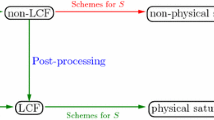Abstract
This paper presents studies on applying the novel weak Galerkin finite element method (WGFEM) to a two-phase model for subsurface flow, which couples the Darcy equation for pressure and a transport equation for saturation in a nonlinear manner. The coupled problem is solved in the framework of operator decomposition. Specifically, the Darcy equation is solved by the WGFEM, whereas the saturation is solved by a finite volume method. The numerical velocity obtained from solving the Darcy equation by the WGFEM is locally conservative and has continuous normal components across element interfaces. This ensures accuracy and robustness of the finite volume solver for the saturation equation. Numerical experiments on benchmarks demonstrate that the combined methods can handle very well two-phase flow problems in high-contrast heterogeneous porous media.








Similar content being viewed by others
References
Arnold, D.N., Brezzi, F.: Mixed and nonconforming finite element methods: implementation, postprocessing and error estimates. RAIRO Modél. Math. Anal. Numér. 19, 7–32 (1985)
Aziz, K., Settari, A.: Petroleum Reservoir Simulation. Applied Science Publishers, Barking (1979)
Bastian, P., Riviere, B.: Superconvergence and \( h(div) \) projection for discontinuous galerkin methods. Int. J. Numer. Methods Fluids 42, 1043–1057 (2003)
Brenner, S.C., Scott, L.R.: The Mathematical Theory of Finite Element Methods. Texts in Applied Mathematics, vol. 15, 3rd edn. Springer, New York (2008)
Bush, L., Ginting, V.: On the application of the continuous galerkin finite element method for conservation problems. SIAM J. Sci. Comput. 35, A2953–A2975 (2013)
Chavent, G., Roberts, J.: A unified physical presentation of mixed, mixed-hybrid finite elements and standard finite difference approximations for the determination of velocities in waterflow problems. Adv. Water Resour. 14, 329–348 (1991)
Chen, Z., Huan, G., Ma, Y.: Computational methods for multiphase flows in porous media. SIAM, Philadelphia (2006)
Cockburn, B., Gopalakrishnan, J., Wang, H.: Locally conservative fluxes for the continuous galerkin method. SIAM J. Numer. Anal. 45, 1742–1776 (2007)
Du, C., Liang, D.: An efficient S-DDM iterative approach for compressible contamination fluid flows in porous media. J. Comput. Phys. 229, 4501–4521 (2010)
Efendiev, Y., Galvis, J., Lazarov, R., Margenov, S., Ren, J.: Robust two-level domain decomposition preconditioners for high-contrast anisotropic flows in multiscale media. Comput. Methods Appl. Math. 12, 415–436 (2012)
Epshteyn, Y., Riviere, B.: Analysis of hp discontinuous galerkin methods for incompressible two-phase flow. J. Comput. Appl. Math. 225, 487–509 (2009)
Ewing, R.: The mathematics of reservoir simulation. SIAM, Philadelphia (1983)
Healy, R., Russell, T.: Solutions of the advection–dispersion equation in two dimensions by a finite volume Eulerian–Lagrangian localized adjoint method. Adv. Water Resour. 21, 11–26 (1998)
Hou, Z., Engel, D., Lin, G., Fang, Y., Fang, Z.: An uncertainty quantification framework for studying the effect of spatial heterogeneity in reservoir permeability on \({\rm CO}_2\) sequestration. Math. Geosci. 45, 799–817 (2013)
Hughes, T.J.R., Engel, G., Mazzei, L., Larson, M.G.: The continuous Galerkin method is locally conservative. J. Comput. Phys. 163, 467–488 (2000)
Iliev, O., Lazarov, R., Willems, J.: Variational multiscale finite element method for flows in highly porous media. Multiscale Model. Simul. 9, 1350–1372 (2011)
Kou, J., Sun, S.: Analysis of a combined mixed finite element and discontinuous Galerkin method for incompressible two-phase flow in porous media. Math. Methods Appl. Sci. 37, 962–982 (2014)
Lin, G., Liu, J., Mu, L., Ye, X.: Weak galerkin finite element methdos for darcy flow: anistropy and heterogeneity. J. Comput. Phys. 276, 422–437 (2014)
Lin, G., Liu, J., Sadre-Marandi, F.: A comparative study on the weak Galerkin, discontinuous Galerkin, and mixed finite element methods. J. Comput. Appl. Math. 273, 346–362 (2015)
Liu, J., Cali, R.: A note on the approximation properties of the locally divergence-free finite elements. Int. J. Numer. Anal. Model. 5, 693–703 (2008)
Raviart P.-A., Thomas, J. M.: A mixed finite element method for 2nd order elliptic problems. In: Mathematical Aspects of Finite Element Methods (Proc. Conf., Consiglio Naz. delle Ricerche (C.N.R.), Rome, 1975), Lecture Notes in Math., vol. 606, pp. 292–315. Springer, Berlin (1977)
Riviere, B.: Discontinuous Galerkin methods for solving elliptic and parabolic equations: theory and implementation. SIAM, Philadelphia (2008)
Sun, S., Liu, J.: A locally conservative finite element method based on piecewise constant enrichment of the continuous galerkin method. SIAM J. Sci. Comput. 31, 2528–2548 (2009)
Thomas, J. W.: Numerical Partial Differential Equations, Vol. 33 of Texts in Applied Mathematics. Springer, New York (1999). Conservation laws and elliptic equations
Wang, H., Liang, D., Ewing, R., Lyons, S., Qin, G.: An approximation to miscible fluid flows in porous media with point sources and sinks by an Eulerian–Lagrangian localized adjoint method and mixed finite element methods. SIAM J. Sci. Comput. 22, 561–581 (2000)
Wang, J., Ye, X.: A weak galerkin finite element method for second order elliptic problems. J. Comput. Appl. Math. 241, 103–115 (2013)
Author information
Authors and Affiliations
Corresponding author
Additional information
V. Ginting was partially supported by US National Science Foundation under Grant DMS-1016283. G. Lin would like to acknowledge support by the Applied Mathematics program of the US DOE Office of Advanced Scientific Computing Research and Pacific Northwest National Laboratory’s Carbon Sequestration Initiative, which is part of the Laboratory Directed Research and Development Program. J. Liu was partially supported by US National Science Foundation under Grant DMS-1419077.
Rights and permissions
About this article
Cite this article
Ginting, V., Lin, G. & Liu, J. On Application of the Weak Galerkin Finite Element Method to a Two-Phase Model for Subsurface Flow. J Sci Comput 66, 225–239 (2016). https://doi.org/10.1007/s10915-015-0021-8
Received:
Accepted:
Published:
Issue Date:
DOI: https://doi.org/10.1007/s10915-015-0021-8
Keywords
- Darcy equation
- Heterogeneity
- Local conservation
- Saturation
- Two-phase flow
- Weak Galerkin finite element methods




